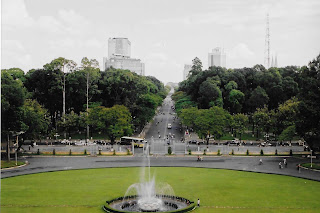These three kids happened to be connected to a private mini-hotel on Nguyen Trung Truc Street in Rach Gia, Kien Giang Province. (Go to Ho Chi Minh City and go west to the Bay of Thailand.) During the American War, the Americans had a prison on Phu Quoc Island, now Kien Giang Province's premiere tourist destination, a tropical paradise that not just has modest privately owned mini-hotels like Tropicana Resort but also (of course) Saigontourist (state run) hotels but also, say, these days lots of places like decidedly upscale Phu Quoc Eco Beach Resort. (Let's hope the local pepper farmers and people who in the past, before the tourist boom, worked in the nuoc mam factories still have jobs or traded upward as the tourist infrastructure grew and grew. It is very unlikely that many Phu Quoc locals would be able to so much as set foot in the local expensive resorts as guests.)
This hotel on the main street of Rach Gia ceased to be after I stayed there. (Remineder: Rach Gia is a city of 200,000 where I was one of 3-4 Westerners: a teacher sponsored by Princeton in Asia; a French woman married to a Vietnamese; and supposedly an Australian woman working in a water quality project) Why did the hotel vanish? Well, the building is still there, but the rumor I heard was that the mini-hotel had been underwritten by American relatives of the locals and somehow because of a dispute, the Americans branch had pulled out. This hotel in Rach Gia was notable because it also offered food.
The children were fortunate because they had family who tended to them--they were not sent out to sell lottery tickets on the street, for instance. Their English was limited to "Hello. What's your name?" And their response was to giggle and run away after I told them my name and asked them theirs.
Another hotel story. I once stayed in a hotel much closer to the beach ("lan bien") that, typical of small family-run hotels, had no restaurant. Initially, I thought the hotel was a good 3-4 very long blocks (sometimes in 100 degree heat) from any local restaurants (and not every restaurant kept regular hours that I could discern). But it turned out that nearby there was a new place called Saigon Pho which, it turned out, was started by a Vietnamese-American who had returned and then opened one of the first restaurant/catering facilities I knew of in the city.
The Vietnamese-American found me the first time I walked in and said "an com" ("Eat rice," or, "I'd like to eat.") He knew an American when he saw one, he made sure I got enough to eat during that visit, and he gave me the short version: he had left this country as a boat person right after the war, done well enough in the US, and had decided to return here--where he had started--since he had retired. He wanted to help his country. His spoken English was as good as mine.
When I told someone local about him, someone who had even met him, I got a different story: surely he had failed in the US so he had to return to Vietnam.
I know which story I believe.










